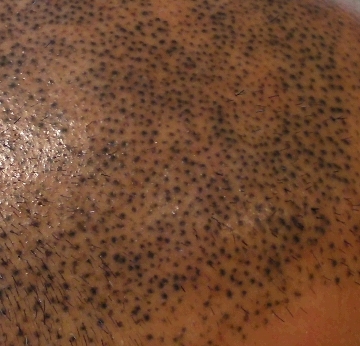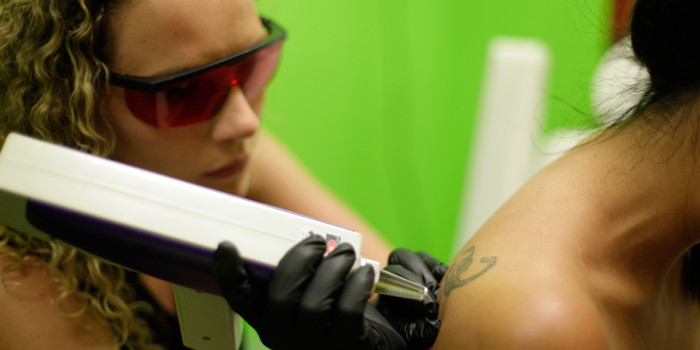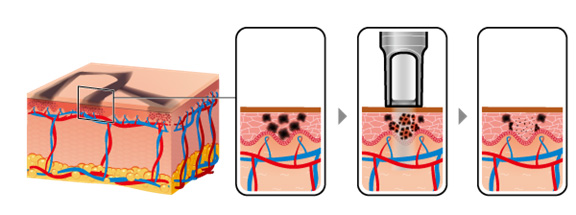Its a sad fact, but the reality is that people consider scalp pigmentation do end up going to companies that don’t say HIS Hair on the door.
Dedicated to providing HIS clients and potential clients alike, the HIS Hair clinic began offering laser removal services for scalp pigmentation and tattoos of all kinds. By expanding the range of services offered without losing focus on our primary objective, HIS gives the client something more than just confidence and a new look: options.
With the addition of our laser removal services, presently available at our Harley Street location in London and soon to be available in the US, HIS provides clients with the option to make alterations to their existing treatment or remove a bad batch of scalp pigmentation done by a different SMP provider.
But what is it?
What Is It and How Does it Work
Before discovering that lasers could be used to remove tattoos, the options available were less sophisticated and could do more damage than good. Procedures like dermabrasion, where the skin is essentially sand-blasted in hopes of removing the pigment from the tattoo, and excision, where a medical professional cuts the tattoo out with a scalpel and sews the wound up were ineffective and now out-dated. Lasers are now the favored method for tattoo removal as they are the cleaner, low risk procedure with less possibility of leaving any residual damage behind. People undergoing a laser removal procedure rarely need any type of anesthesia to complete the treatment.
Laser tattoo removal works by the laser producing short bursts of intense light that penetrate through the top layers of the skin. These pulses of light are then absorbed by the pigment, which causes the tattoo pigment to fragment in small particles. The fragmented particles of pigment are then removed by the body’s immune system and disappear.
The type of laser selected for the job largely depends on the pigment colors of the tattoos. The pigment color decides what wavelength to use with the laser. As black pigment absorbs all wavelengths, it’s the easier color to remove.
The technique developed that for laser tattoo removal is called ‘Q-switching’, “which refers to the laser’s short, high-energy pulses.” The high-energy bursts of light are focused over the tattoo area and, as mentioned, the light breaks up the pigment which are then removed by scavenger cells that destroy the pigment.
These tattoo removal sessions only take but a few minutes, but typically require multiple sessions to completely remove a full tattoo. Patience is key here, as three weeks is required between sessions to allow time for the body to absorb the pigment.
Whose is it right for?
 As mentioned, laser removal gives clients an add assurance that if they are unsatisfied about the results or wish to make a change, laser removal gives the client the option to alter their treatment. For clients who find themselves on the wrong end of a bad scalp pigmentation, laser removal can provide clients with a clean slate.
As mentioned, laser removal gives clients an add assurance that if they are unsatisfied about the results or wish to make a change, laser removal gives the client the option to alter their treatment. For clients who find themselves on the wrong end of a bad scalp pigmentation, laser removal can provide clients with a clean slate.
London client Andre underwent a scalp pigmentation procedure with a different company on Harley Street. He was told that the scalp pigmentation would blend perfectly with his natural hair. Needless to say, the results didn’t come out exactly how he anticipated, leaving Andre with an uneven looking hairline and temple area.
“I don’t think they were very experienced particularly in doing this [scalp pigmentation] procedure,” Andre said. He found his way to HIS in London and underwent laser removal. Each session, spaced about eight weeks apart, yielded a significant improvement. Andre was able to have the poorly applied scalp pigmentation removed, giving him a clean hairline to work with.
Laser removal isn’t reserved for the reversal of a bad decisions. Sometimes, you just change your mind.
John came back to HIS Hair two years after completing his original SMP treatment. He was very happy with the outcome of his treatment, but just wanted to switch up his look. Originally opting for a sharper, more defined hairline, Chris saw other clients sporting a more natural, ‘feathered’ hairline and decided that’s the look he would want to go with. “The feathered look just looks so much more natural,” Chris commented.
“I think it’s reassuring that HIS can undo the work in case you decide to, like I did, if you want to change your hairline, or alter the hairline or the shape, or the softness of it. So I think it’s really good and very reassuring to know that you can have the work undone and redone, as it were, as and when needed.” To see his results, click here.
If you have undergone a SMP treatment procedure with a different company and didn’t get the results you were hoping for, we invite you to contact us for a free consultation. Any one of our consultants would be happy to discuss the benefits of laser removal and guide you in the right direction.
Whatever your need or interest may be with pursuing laser removal, be sure to check with your dermatologist for any recommendations for the right laser removal provider for you.



